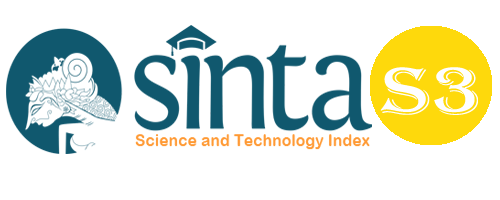The Effect of Employee Competence on Increasing Employee Motivation in Sumut Bank of Sharia Unit, North Sumatera
Abstract
This study aims to analyze the effect of employee competence on increasing employee motivation in Sumut Bank of Sharia Unit, North Sumatera. This research uses descriptive and verification methods. The place of research was conducted at Sumut Bank of Sharia Unit, North Sumatera. Considering the nature of this research is descriptive and verification, the research method used is descriptive survey and explanatory survey method. The type of investigation in this research is causality, which is testing the causal relationship between independent variables, intervening variables, moderating variables and dependent variables. The unit of analysis in this study is the employees at Sumut Bank of Sharia Unit, North Sumatera. The result shows that Competence in Sumut Bank of Sharia Unit, North Sumatera is perceived as poor to good. The highest average value is an indicator of the ability of employees to express narratives, meaning that employees actually have the ability to carry out their duties but are still not optimal. Nevertheless there are still some weaknesses in the indicator of the ability of employees to holistically look at problems in their lives. The experts also agree with the findings of researchers, and said competence still dominates important factors in the banking business, even sharia bank employees need to have special competencies.
Keywords
Full Text:
PDFReferences
Amstrong, Michael dan Murlis, Helen, 2003, “Reward Management” A Handbook Remuneration Strategy And Practice. Fourt Edition.
Daft, Richard L 2002,. Manajemen(Jilid 1, Edisike—5), Erlangga, Jakarta,
Dessler, Gary, 2006, ManajemenSumberDayaManusia, Terj. Edisike- 10 jilid 1, Indeks, Jakarta.
DidiTurmudzi, 2012, BudayaOrganisasi, Prisma Press, Bandung.
Kotter P. JhondanHeskett L. James, 2007, “Coorporate Culture and Performance”, Dampak Budaya Perusahaan terhadap Kinerja, Person Education Asia, Jakarta.
Mathis, Robert Ldan John H. Jacson, 2006, Human Resource Management (Manajemen Sumber Daya Manusia). Ed ke- 10, Salemba Empat, Jakarta.
Mondy R Wayne, 2008,“ Manajemen Sumber Daya Manusia” Edisi – 10 Jilid 2, Penerbit Erlangga, Jakarta.
Montana, Patrick J. &Charnov Bruce H, 2008, Management (Fourth Edition), Barron’s, New York.
Raymond A. Noe, Jhon R.H., Barry G. Patrick M.W, 2010, Manajemen Sumber Daya Manusia, Mencapai Keunggulan Bersaing. Buku 1. Edisi Keenam, Penerbit Salemba Empat, Jakarta.
Riani, Asri Laksmi, 2011,Perspektif Kompensasi. (cet. Ke-2), Yuma Pustaka, Surakarta.
Rivai, H. Veithzal dan Ella Jauvani Sagala., 2009. Manajemen Sumber Daya Manusia Untuk Perusahaan, PT. Raja Grafindo Persada, Jakarta.
Rivai, H. Veithzal, et. al, 2008, Performance Appraisal, Edisi ke- 2, PT. Raja Grafindo Persada, Jakarta.
Sedarmayanti, Hj, 2009, Manajemen Sumber Daya Manusia Reformasi Birokrasi dan Manajemen Pegawai Negeri Sipil, Aditama Bandung.
Simamora, Henry, 2004, Manajemen Sumber Daya Manusia, STIE YKPN, Yogyakarta.
Soekarso,. 2010, Teori Kepemimpinan, Mitra Wacana Media, Jakarta.
Sutrisno, Edi. 2010,Budaya Organisasi, Kencana, Jakarta.
Sunyoto, Danang dan Burhanudin, 2011,Perilaku Organisasi, Caps, Yogyakarta.
Tika, H. Moh. Pabundu, 2010, Budaya Organisasi dan Peningkatan Kinerja, Bumi Aksara, Jakarta.
Tjahjono, Herry, 2010, Culture Based Leadership, Kompas Gramedia, Jakarta.
Widayatmini dan Luqman Hakim. 2008. Hubungan Kepemimpinan, Kompensasi dan Kompetensi Terhadap Kinerja Pegawai Dinas Kesehatan Kota Depok. No. 2 Vol. 13 di: http//ejournal.gunadarma. ac.id/index.php/ekbis/article/view/308/247 diakses tanggal 15 Mei 2010
Wijaya, Muksin. 2005. Kepemimpinan Transformasional di Sekolah dalam Meningkatkan Outcomes Peserta Didik, Jurnal Pendidikan Penabur No. 5/Th. IV/Desember 2005
Kusdi. 2008. Membangun Organisasi melalui Pendekatan Budaya. Universitas Brawijaya Malang
Undang-undang Ketenaga kerjaan No 13 tahun 2003, pasal 1ayat 10
DOI: https://doi.org/10.33258/birci.v3i2.913
Article Metrics
Abstract view : 816 timesPDF - 651 times
Refbacks
- There are currently no refbacks.

This work is licensed under a Creative Commons Attribution-ShareAlike 4.0 International License.

This work is licensed under a Creative Commons Attribution-ShareAlike 4.0 International License.

_.gif)

















_.gif)



